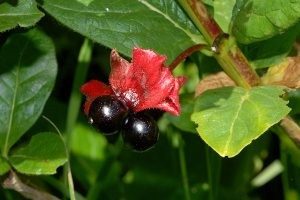Secwepemc names: whole stem: kenkeknem sq’wlus tsitsen (“black bear’s berries”); OR skwleqs q’lus tsius
 Black Twinberry, or Twinflower Honeysuckle, or “Bear Berry”. Known as a food for bears, the berries were not normally eaten by people. This plant was mixed together with snowberry and yarrow to make a medicine for arthritis. The stems were put into boiling water and the solution was allowed to cool. It was then used as a wash for the legs, or whatever was affected, for example with eczema; it was used only externally, not taken as tea.
Black Twinberry, or Twinflower Honeysuckle, or “Bear Berry”. Known as a food for bears, the berries were not normally eaten by people. This plant was mixed together with snowberry and yarrow to make a medicine for arthritis. The stems were put into boiling water and the solution was allowed to cool. It was then used as a wash for the legs, or whatever was affected, for example with eczema; it was used only externally, not taken as tea.
Ecological requirements: Widespread throughout the province in moist areas, swamps, wetlands, and valley bottoms.
![]()
